The DTE Notebook for the Urban Organic Vegetable, Herb, and Flower Gardener
Reducing the Use of Plastic in Gardening.
Article and photos by Rob Danforth
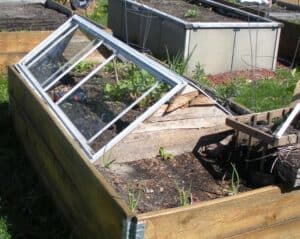
In the long run, gardening contributes an enormous amount of plastic waste: tools, scoops, tool handles, plant containers, composters, watering cans, rain barrels, buckets, trugs, poly tunnels, plant markers, sun screens, tarpaulins, garden thermometers, rain gauges, hose guides, some hoses, some bird feeders, anti-bird spikes, bug/slug/snail traps, seeders, fertilizer spreaders, garbage bags, plastic-coated plant supports, indoor seed trays, indoor seedling pots, pots from purchased plants & seedlings, cloches, microgreen trays, PVC hoops, spray bottles, storage containers, plastic sheeting (e.g., liners, covers, mulches), zip ties, plastic coated wire, bird netting, and numerous bags (e.g., soil, compost, composted manure, fertilizers, mulch, soil additives), etc.
Plastic is a very long-lasting, oil-based product, often susceptible to UV damage but slow to break down. As plastics break down, minute particles are getting into all kinds of items (e.g., landfill, garden soil, ground water, rivers, fish, sea salt, … and all of us)! There are even microplastic particles deliberately added to body lotions and toothpastes.
Plastic is undoubtedly helpful and convenient for gardeners, and we are not suggesting plastic-free gardening, but if the amount involved concerns you, then choosing durable, UV resistant plastic; re-using plastic for as long as possible; recycling it when it is past use or seriously UV damaged; avoiding single use plastic; and substituting alternatives can help to reduce the amount of plastic waste.
However, transitioning to reduced plastic gardening might take few growing seasons!
In addition to reusing and recycling plastic, here are a few ideas for substitutions:
Soil: If you purchase garden soil, get a cubic yard or more via dump truck or returnable bag rather than many small plastic bags of soil. If a cubic yard is too much, why not share with neighbours?
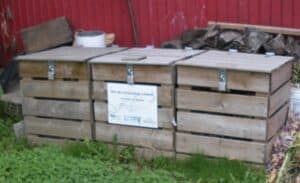
Compost: make your own compost year-round in a do-it-yourself wooden compost box (4 ventilated sides, no floor, and a hinged cover). Aerate the compost from time to time to redistribute moisture, air, and composting agents. Note: proper composting does not smell offensive. Spreading compost in the fall will make room in your composter for winter additions. For Fall composting, when there is a glut of compostable garden waste to overflow your composter, cut-and-drop the soft parts of plants (e.g., leaves, fruit, flowers, grass clippings, shrub trimmings & seedless weeds) on the soil surface to act as a mulch, and compost only the tougher parts (e.g., chopped up roots, stalks, vines, & woody bits). All winter, continue to add to the composter all kitchen vegetables, herb, and fruit trimmings as well as tea bags, coffee & filters, and some shredded cardboard (e.g., egg cartons, tubes from Christmas wrap & toilet roll cores).
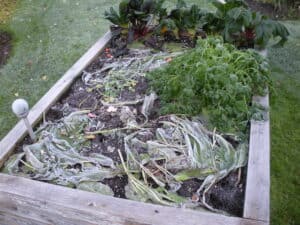
Indoor Seed Pots: choose homemade pots of brown paper or newsprint; small, re-useable terracotta or bamboo pots; somewhat re-useable starch pots; or one time use cow manure pots (no smell, no pathogens, and a definitely renewable resource). Also, seeds can be started in large tin cans, trays, or recycled items as beds – it is convenient, but not necessary to have one pot per seedling!
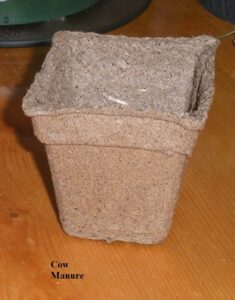
Seed Pot Markers/Labels: try wooden popsicle sticks or tongue depressors and a pen, or just write on the pot with a wax marker.
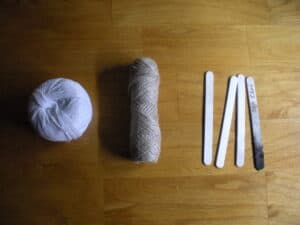
Seed Pot Trays: try containers that will last a long time such as non-stick cookie sheets with sides. Just add a layer of kitchen scrubby for pots to sit on so that they can drain. Avoid flimsy plastic trays that are often doubled because of leaking pin holes in the weak corners.
Water: save rain or tap water in wooden barrels, metal drums, or farm watering troughs. Water plant roots with metal watering cans – they used to be standard.
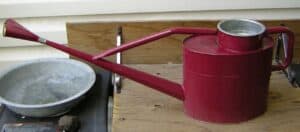
Plant Containers: experiment with ceramic, resin, black fabric, terracotta, metal, or untreated, unpainted wood — eastern white cedar and hemlock last longest (approximately 15 yr.) but plain spruce, pine, fir or hardwoods, will also work (3 to 5 yrs.).
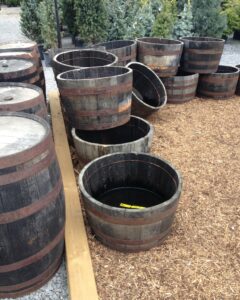
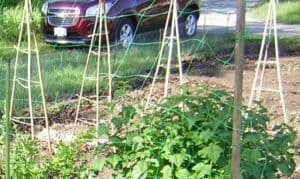
Supports: use stakes and tripods of bamboo; unpainted, untreated wood; foraged sticks; greenwood trimmings, or metal (spirals or rods); ties: sisal, cloth strips, cotton “butcher’s twine,” or galvanized wire; trellis netting: wood lattice, sisal, or chicken wire sheets.
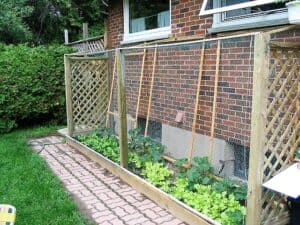
- Critter barriers: make re-useable wire/steel hoops or wood/bamboo frames covered with fabric, chicken wire, or “hardware cloth.” Tip: spending more time in the garden is an excellent critter deterrent!
- Cutworm sleeves: encircle the seedling with a metal can or cardboard, 3 inches above ground & 1 inch below. Bind cardboard with sisal, string, wool, wire or masking tape. Note: if you use a metal can, you will need metal shears to remove it later in the season.
- Squash vine bore sleeves: wrap the base of the stem from the ground to 8 inches along in aluminum foil.
- Winged bug barriers: use floating row covers or old bed sheets over bamboo, metal, or wooden frames or metal hoops. Bind frames with sisal, string, or galvanized wire.
- Mulches: try shredded leaves (very effective!), straw, grass clippings, or woody bits from pruning. Add an optional underlay of newsprint (3-5 sheets) or clean cardboard sheets (both biodegradable, and both add carbon to the soil) beneath mulch to prevent weed growth. Tip: we use shredded leaves without the underlay for 95% effective weed suppression. [pic: leaf mulch, wood border]
- Cloches and poly tunnels: replace with a permanent cold frame with a glass cover (Tip: recycled storm doors work well) to protect plants from cold and wind. Start seeds in the cold frame in the spring, open it up for tall plants in summer, and relocate plants into the frame for fall protection over winter.
Tools: choose all metal tools or tools with wood handles.
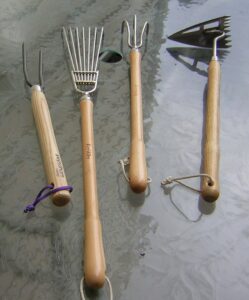
Reducing plastic is a definite challenge, but any steps we can take will help the environment, save money, and in some cases save time and effort. No need to be plastic free, but perhaps with our efforts, an awful lot less will be blue boxed or trashed! Happy Gardening!
More Articles: https://ottawa.cog.ca/seasonal-resources/